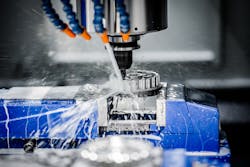In the decade since the beginning of the Great Recession industrial production (e.g. manufacturing, mining and electricity production) has been a political football of both the left and right. It’s time to stop playing that game, and a good way to start is to review some facts about these industries, which continue to provide a significant share of the Midwestern economy.
We are, right now, at the peak of industrial production in the United States. By every measure of production, we are at record levels. The industrial production index peaked in December 2007, then dropped by roughly 15% by the summer of 2009. It took five years to recover to a second peak in 2015. As the world economy dipped in 2015 and 2016, so too did U.S. industrial production. We are back at a record level of industrial output. It’s worth noting that total U.S. industrial production is more than twice what it was back in 1979, when employment peaked. And yes, of course, that is adjusted for inflation.
Other measures tell the same story. Inflation-adjusted manufacturing GDP will peak in 4th quarter 2017, both in dollar and quantity index measures. Importantly, new data on value-added of manufacturing offers an even more interesting insight into America’s manufacturing strength. Value-added is a measure of production that subtracts all the goods used in production. By making this calculation across all U.S. manufacturing, we omit all the spending by factories on imported parts. That number is at a record high right now, a full decade after the start of the Great Recession.
Given the abundance of facts about manufacturing’s strong position in the U.S. economy, why would anyone argue that it is even struggling, much less in decline? Other than ignorance or malevolence, I don’t have a good answer to that question. As a professor, I think I can help on the former.
Manufacturing employment, which all too many folks think is a good sign of the industry’s health, is about 1.5 million less than it was at the start of the Great Recession and about a third lower than at its peak month in 1979. While manufacturing employment has gained a full million jobs since the end of the recession, that rebound seems to be slowing. Still, the loss of manufacturing employment has been swamped by growth in other sectors. For every job we’ve lost in manufacturing since December 2007, we’ve gained six jobs in other sectors. The problem is the new jobs require different skills in different places. Moreover, turnover within manufacturing has had a very uneven effect on workers.
Since about 2000, manufacturing jobs held by non-college graduates have declined by almost 45%, while manufacturing jobs held by those with a college degree are up almost 17%. That means in net, all the new jobs and almost all the replacement jobs in manufacturing are going to college graduates. That trend also accelerated during the Great Recession.
Geographically, there was very little relocation of manufacturing between rural and urban places since the start of the recession. But, the longer trend is far more disruptive, with nearly seven times the manufacturing GDP growth in urban American than rural America since 2000. That trend has returned since 2009, with the bulk of manufacturing GDP flowing to urban places. This is unsurprising, since that is where the new workers that manufacturing firms need are located.
Economists call this agglomeration, but it looks like urbanization to demographers. Since 2001, 60% of all manufacturing GDP growth has occurred in just 10 cities, the smallest of which is about 2.2 million people. More than one in four metropolitan areas actually lost manufacturing GDP during this period.
The quite simple truth is that manufacturing in American is doing extremely well and is enjoying record levels of production. At the same time, the places factories are located and the people who work in these factories have gone through epic change. As economists have been saying for some time, the big winners in this transformation are college graduates with technical degrees located in large urban places. This trend will continue for the remainder of the 21st century.
Michael J. Hicks, PhD, is the director of the Center for Business and Economic Research and the George and Frances Ball distinguished professor of economics in the Miller College of Business at Ball State University. Hicks earned doctoral and master’s degrees in economics from the University of Tennessee and a bachelor’s degree in economics from Virginia Military Institute. He has authored two books and more than 60 scholarly works focusing on state and local public policy, including tax and expenditure policy and the impact of Wal-Mart on local economies.
About the Author
Michael Hicks
Professor
Michael J. Hicks, PhD, is the director of the Center for Business and Economic Research and the George and Frances Ball distinguished professor of economics in the Miller College of Business at Ball State University. Hicks earned doctoral and master’s degrees in economics from the University of Tennessee and a bachelor’s degree in economics from Virginia Military Institute. He has authored two books and more than 60 scholarly works focusing on state and local public policy, including tax and expenditure policy and the impact of Wal-Mart on local economies.
